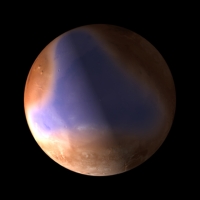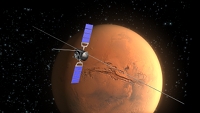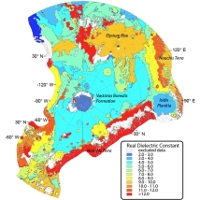Mars radar finds possible ocean sediments
6 February 2012
The MARSIS radar instrument on board ESA's Mars Express orbiter has discovered a subsurface blanket of low density material around the north polar cap, supporting theories that the northern lowlands of Mars were once covered by a large body of water. |
| Artist's impression of an ancient northern ocean on Mars. Credit: ESA |
Although Mars is currently a frozen desert where liquid water cannot exist on the surface for more than a few seconds, there is plenty of evidence that the planet was once much wetter. Particularly striking are the enormous channels – now dry - which were carved by raging torrents of sediment-laden water. These relatively short-lived flash floods seem to have occurred episodically from the late Noachian period until the early Amazonian period, between 4 billion and 2 billion years ago.
The majority of these outflow channels disgorged onto the vast lowlands which surround the ice cap at the north pole, leading many scientists to favour the idea that they fed a shallow Martian ocean that once covered more than 30 per cent of the planet's surface.
Indications have also been found of possible ancient shorelines that may have been eroded by waves several billion years ago. Within these shorelines, a possible sedimentary remnant of a former ocean, known as the Vastitas Borealis Formation, was recognised on the basis of geomorphologic and topographic observations. Now analysis of MARSIS radar data has provided further geophysical evidence in favour of a northern ocean.
 |
| The MARSIS radar deployed over Mars. Credit: ESA. |
The radar probes the nature of the planet's subsurface by revealing contrasts in dielectric constant. In the case of Mars, these variations are caused by two main parameters: the density of the materials and the amount of ice in the ground. A high dielectric value indicates the presence of dense material, whereas a low value shows a fairly low density or high content of ice.
Unlike previous observations, which have only been able to study the surface of Mars, the MARSIS low-frequency sounding radar is able to probe the subsurface regions to depths of 60-80 m. Its observations of the planet's hidden layers provide new insights into what Mars was like in the distant past.
In a paper published in Geophysical Research Letters, an international team of researchers has compared the physical properties of the subsurface materials around the south and north poles by analysing two years of MARSIS data. Their maps reveal some fundamental differences between the two hemispheres.
 |
| Mars Express/MARSIS maps of Martian hemispheres. Image courtesy of J. Mouginot et al. |
In the northern hemisphere, the MARSIS dielectric map shows a very different pattern. The region with low dielectric value extends towards the equator, far beyond the latitudes where shallow subsurface ice is expected to be stable. This huge area covers the northern plains and extends toward lower latitudes in the regions of Amazonis Planitia (150°W), Chryse Planitia (30°W) and Utopia Planitia (100°E).
 |
| Mars Express/MARSIS map of Martian northern hemisphere. Image courtesy of J. Mouginot et al. |
"The measured value can only be explained by the presence of low density sedimentary deposits, massive deposits of ground ice, or a combination of the two," explained Jérémie Mouginot, lead author of the paper, who undertook the research as a PhD student under the leadership of Wlodek Kofman at the Institut de Planétologie et d'Astrophysique in Grenoble, France. Mouginot is currently a researcher at the University of California, Irvine.
"It is not possible to distinguish between these different compositions. However, we can definitely say that the Vastitas Borealis Formation is not made of hardened volcanic flows, as some have suggested."
Of particular interest to the team is the apparent correspondence between the region of low dielectric values and the postulated northern ocean.
"The presence of low density material, potentially mixed with ice, suggests that we are observing sedimentary material, tens of metres thick, that was eroded by fast-flowing water and carried downstream before being deposited in an ocean," said Wlodek Kofman, co-author of the paper and a co-investigator on the MARSIS instrument team.
"The pattern of low dielectric values is consistent with the extent of the Vastitas Borealis Formation, which extends toward low latitudes and encompasses the three main catchment areas of the large outflow channels that emanate from the southern highlands. The evidence clearly points toward an oceanic origin for the shallow subsurface."
"The MARSIS subsurface radar gives us new and complementary information about the history and distribution of water on Mars, compared to previous results," said Olivier Witasse, ESA's Mars Express Project Scientist. "This adds new pieces to the puzzle. The question still remains: where did all the water go?"
Reference publication
"Dielectric map of the Martian northern hemisphere and the nature of plain filling materials" by Jeremie Mouginot, Antoine Pommerol, Pierre Beck, Wlodek Kofman, and Stephen M. Clifford, Geophysical Research Letters, Vol. 39, L02202, 2012. DOI: 10.1029/2011GL050286
Contacts
Jérémie Mouginot
Department of Earth System Science
University of California, Irvine, USA
Phone: (mobile) +1 949 202 7132, (office) +1 949 824 3931
Email: jmougino uci.edu
uci.edu
Wlodek Kofman
Conseiller scientifique auprès du DGAR, Ecole Polytechnique
Institut de Planetologie et d'Astrophysique de Grenoble, France
Phone: +33 476514147
Email: wlodek.kofman obs.ujf-grenoble.fr
obs.ujf-grenoble.fr
Olivier Witasse
Mars Express Project Scientist
Research and Scientific Support Department
ESA Directorate of Science & Robotic Exploration
Noordwijk, The Netherlands
Phone: +31 71 5658015
Email: Olivier.Witasse esa.int
esa.int


